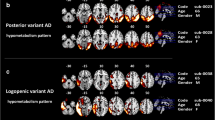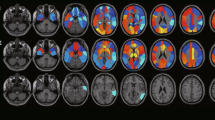Abstract
Purpose
We tested the hypothesis that lateralized hemispheric glucose metabolism may have diagnostic implications in Alzheimer’s disease (AD) and mild cognitive impairment (MCI).
Methods
We performed FDG-PET/CT in 23 patients (mean age 63.7 years, range 50–78, 17 females) diagnosed with AD (n = 15) or MCI (n = 8) during a six-month period in 2014. Ten neurologically healthy individuals (HIs) (mean age 62.5 years, range 43–75, 5 females) served as controls. A neuroimaging expert provided visual assessment of diaschisis. The total hemispheric glucose metabolism ratio (THGr) was calculated, and with area-under the curve of receiver operating characteristics (AUC-ROC) we generated a “Network Diaschisis Test (NDT)”.
Results
The qualitative detection of cerebral (Ce) and cerebellar (Cb) diaschisis was 7/15 (47%), 0/8 (0%), and 0/10 (0%) in AD, MCI, and HI groups, respectively. Median cerebral THGr was 0.68 (range 0.43–0.99), 0.86 (range 0.64–0.98), and 0.95 (range 0.65–1.00) for AD, MCI, and HI groups, respectively (p = 0.04). Median cerebellar THGr was, respectively, 0.70 (range 0.18–0.98), 0.70 (range 0.48–0.81), and 0.84 (range 0.75–0.96) (p = 0.0138). A positive NDT yielded a positive predictive value of 100% for the presence of AD or MCI and a 86% negative predictive value for healthy brain. Moreover, the diagnostic manifestation of THGr between MCI and AD led to a positive predictive value of 100% for AD, but a negative predictive value of 42.9% for MCI.
Conclusion
Patients with AD or MCI had more pronounced diaschisis, lateralized hemispheric glucose metabolism and lower THGr compared to healthy controls. The NDT distinguished AD and MCI patients from HIs, and AD from MCI patients with a high positive predictive value and moderate and low negative predictive values. THGr can be a straightforward source of investigating neuronal network diaschisis in AD and MCI and in other cerebral diseases, across institutions.




Similar content being viewed by others
References
von Monakow C. Die Localization im Grosshirn und der Abbau der Funktion durch korticale Herde, Wiesbaden. Germany: JF Bergmann; 1914.
Kang KM, Sohn CH, Choi SH, Jung KH, Yoo RE, Yun TJ, et al. Detection of crossed cerebellar diaschisis in hyperacute ischemic stroke using arterial spin-labeled MR imaging. PLoS One. 2017;12:e0173971. https://doi.org/10.1371/journal.pone.0173971.
Abe O, Okubo T, Hayashi N, Saito N, Iriguchi N, Shirouzu I, et al. Temporal changes of the apparent diffusion coefficients of water and metabolites in rats with hemispheric infarction: experimental study of transhemispheric diaschisis in the contralateral hemisphere at 7 tesla. J Cerebr Blood F Met. 2000;20:726–35. https://doi.org/10.1097/00004647-200004000-00010.
Patronas NJ, Di Chiro G, Smith BH, De La Paz R, Brooks RA, Milam HL, et al. Depressed cerebellar glucose metabolism in supratentorial tumors. Brain Res. 1984;291:93–101.
DeLaPaz RL, Patronas NJ, Brooks RA, Smith BH, Kornblith PL, Milam H, et al. Positron emission tomographic study of suppression of gray-matter glucose utilization by brain tumors. Am J Neuroradiol. 1983;4:826–9.
Alavi A, Mirot A, Newberg A, Alves W, Gosfield T, Berlin J, et al. Fluorine-18-FDG evaluation of crossed cerebellar diaschisis in head injury. J Nucl Med. 1997;38:1717–20.
Akiyama H, Harrop R, McGeer PL, Peppard R, McGeer EG. Crossed cerebellar and uncrossed basal ganglia and thalamic diaschisis in Alzheimer's disease. Neurology. 1989;39:541–8.
Scholl M, Damian A, Engler H. Fluorodeoxyglucose PET in neurology and psychiatry. PET Clin. 2014;9:371–90, v. https://doi.org/10.1016/j.cpet.2014.07.005.
Sporns O, Tononi G, Kotter R. The human connectome: a structural description of the human brain. PLoS Comput Biol. 2005;1:e42. https://doi.org/10.1371/journal.pcbi.0010042.
Glasser MF, Coalson TS, Robinson EC, Hacker CD, Harwell J, Yacoub E, et al. A multi-modal parcellation of human cerebral cortex. Nature. 2016;536:171–8. https://doi.org/10.1038/nature18933.
Savio A, Funger S, Tahmasian M, Rachakonda S, Manoliu A, Sorg C, et al. Resting state networks as simultaneously measured with fMRI and PET. J Nucl Med. 2017. https://doi.org/10.2967/jnumed.116.185835.
Magistretti PJ. Neuron-glia metabolic coupling and plasticity. J Exp Biol. 2006;209:2304–11. https://doi.org/10.1242/jeb.02208.
Delbeuck X, Van der Linden M, Collette F. Alzheimer's disease as a disconnection syndrome? Neuropsychol Rev. 2003;13:79–92.
Delbeuck X, Collette F, Van der Linden MI. Alzheimer’s disease a disconnection syndrome? Evidence from a crossmodal audio-visual illusory experiment. Neuropsychologia. 2007;45:3315–23.
Segtnan EA, Gjedde A, Høilund-Carlsen PF. A new PET method for quantification of total hemispheric glycolysis and diaschisis: A case report in a patient with stroke 13 years ago. 10th FENS Forum of Neuroscience; Copenhagen 2016.
Segtnan EA, Grupe P, Jarden JO, Gerke O, Ivanidze J, Christlieb SB, et al. Prognostic implications of total hemispheric glucose metabolism ratio in cerebro-cerebellar diaschisis. J Nucl Med. 2017;58:768–73. https://doi.org/10.2967/jnumed.116.180398.
Baron JC, Levasseur M, Mazoyer B, Legault-Demare F, Mauguiere F, Pappata S, et al. Thalamocortical diaschisis: positron emission tomography in humans. J Neurol Neurosur Ps. 1992;55:935–42.
Lolk A, Nielsen H, Andersen K, Andersen J, Kragh-Sorensen P. CAMCOG as a screening instrument for dementia: the Odense study. Cambridge cognitive examination. Acta Psychiatr Scand. 2000;102:331–5.
Coffin M, Sukhatme S. Receiver operating characteristic studies and measurement errors. Biometrics. 1997:823–37.
Drzezga A, Lautenschlager N, Siebner H, Riemenschneider M, Willoch F, Minoshima S, et al. Cerebral metabolic changes accompanying conversion of mild cognitive impairment into Alzheimer's disease: a PET follow-up study. Eur J Nucl Med Mol Imaging. 2003;30:1104–13. https://doi.org/10.1007/s00259-003-1194-1.
Fouquet M, Desgranges B, Landeau B, Duchesnay E, Mezenge F, de la Sayette V, et al. Longitudinal brain metabolic changes from amnestic mild cognitive impairment to Alzheimer’s disease. Brain. 2009;132:2058–67. https://doi.org/10.1093/brain/awp132.
Greicius MD, Krasnow B, Reiss AL, Menon V. Functional connectivity in the resting brain: a network analysis of the default mode hypothesis. Proc Natl Acad Sci USA. 2003;100:253–8. https://doi.org/10.1073/pnas.0135058100.
Weise CM, Chen K, Chen Y, Kuang X, Savage CR, Reiman EM. Left lateralized cerebral glucose metabolism declines in amyloid-beta positive persons with mild cognitive impairment. Neuroimage Clin. 2018;20:286–96. https://doi.org/10.1016/j.nicl.2018.07.016.
Mesulam MM, Weintraub S, Rogalski EJ, Wieneke C, Geula C, Bigio EH. Asymmetry and heterogeneity of Alzheimer's and frontotemporal pathology in primary progressive aphasia. Brain. 2014;137:1176–92. https://doi.org/10.1093/brain/awu024.
Musiek ES, Saboury B, Mishra S, Chen Y, Reddin JS, Newberg AB, et al. Feasibility of estimation of brain volume and 2-deoxy-2-(18)F-fluoro-D-glucose metabolism using a novel automated image analysis method: application in Alzheimer's disease. Hellenic J Nucl Med. 2012;15:190–6. https://doi.org/10.1967/s002449910052.
Alavi A, Newberg AB, Souder E, Berlin JA. Quantitative analysis of PET and MRI data in normal aging and Alzheimer's disease: atrophy weighted total brain metabolism and absolute whole brain metabolism as reliable discriminators. J Nucl Med: Off Publ, Soc Nucl Med. 1993;34:1681–7.
Mosconi L, Brys M, Switalski R, Mistur R, Glodzik L, Pirraglia E, et al. Maternal family history of Alzheimer's disease predisposes to reduced brain glucose metabolism. Proc Natl Acad Sci USA. 2007;104:19067–72. https://doi.org/10.1073/pnas.0705036104.
Rodell AB, O'Keefe G, Rowe CC, Villemagne VL, Gjedde A. Cerebral blood flow and Abeta-amyloid estimates by WARM analysis of [11C]PiB uptake distinguish among and between neurodegenerative disorders and aging. Front Aging Neurosci. 2016;8:321. https://doi.org/10.3389/fnagi.2016.00321.
Kern W, Buchner T, Wormann B, Ritter J, Creutzig U, Hiddemann W. Akute Leukämien Prognostische Faktoren und Therapiestrategien. Internist. 1999;40:983–6. https://doi.org/10.1007/s001080050427.
Guo CC, Tan R, Hodges JR, Hu X, Sami S, Hornberger M. Network-selective vulnerability of the human cerebellum to Alzheimer's disease and frontotemporal dementia. Brain. 2016;139:1527–38. https://doi.org/10.1093/brain/aww003.
Catafau AM, Bullich S, Seibyl JP, Barthel H, Ghetti B, Leverenz J, et al. Cerebellar amyloid-beta plaques: how frequent are they, and do they influence 18F-Florbetaben SUV ratios? J Nucl Med: Off Publ, Soc Nucl Med. 2016;57:1740–5. https://doi.org/10.2967/jnumed.115.171652.
Lyoo CH, Ikawa M, Liow JS, Zoghbi SS, Morse CL, Pike VW, et al. Cerebellum can serve as a pseudo-reference region in Alzheimer disease to detect neuroinflammation measured with PET radioligand binding to translocator protein. J Nucl Med: Off Publ, Soc Nucl Med. 2015;56:701–6. https://doi.org/10.2967/jnumed.114.146027.
Irwin RJ, Irwin TC. A principled approach to setting optimal diagnostic thresholds: where ROC and indifference curves meet. Eur J Intern Med. 2011;22:230–4. https://doi.org/10.1016/j.ejim.2010.12.012.
Altman DG. ROC curves and confidence intervals: getting them right. Heart. 2000;83:236.
Chirles TJ, Reiter K, Weiss LR, Alfini AJ, Nielson KA, Smith JC. Exercise training and functional connectivity changes in mild cognitive impairment and healthy elders. J Alzheimers Dis. 2017;57:845–56. https://doi.org/10.3233/JAD-161151.
Heyn P, Abreu BC, Ottenbacher KJ. The effects of exercise training on elderly persons with cognitive impairment and dementia: a meta-analysis1. Arch Phys Med Rehabil. 2004;85:1694–704.
Acknowledgments
Asbjoern Hrobjartsson, Casper Strandholdt and Andreas Andersen are acknowledged for fruitful discussions of creating an exploratory diagnostic test and pathological aspects of dementia. Sofie Bæk Christlieb is acknowledged for help with the manuscript.
Funding
This article was not funded by any grants.
Author information
Authors and Affiliations
Corresponding author
Ethics declarations
Conflict of interest
All authors declare that they have no conflict of interest.
Ethical approval
All procedures performed in this study involving human participants were in accordance with the ethical standards of the institutional and/or National Research Committee and with the 1964 Helsinki declaration and its later amendments or comparable ethical standards.
Informed consent
Informed consent was obtained from all individual participants for whom identifying information is included in this article.
Additional information
Publisher’s Note
Springer Nature remains neutral with regard to jurisdictional claims in published maps and institutional affiliations.
Rights and permissions
About this article
Cite this article
Segtnan, E.A., Majdi, A., Constantinescu, C. et al. Diagnostic manifestations of total hemispheric glucose metabolism ratio in neuronal network diaschisis: diagnostic implications in Alzheimer’s disease and mild cognitive impairment. Eur J Nucl Med Mol Imaging 46, 1164–1174 (2019). https://doi.org/10.1007/s00259-018-4248-0
Received:
Accepted:
Published:
Issue Date:
DOI: https://doi.org/10.1007/s00259-018-4248-0




